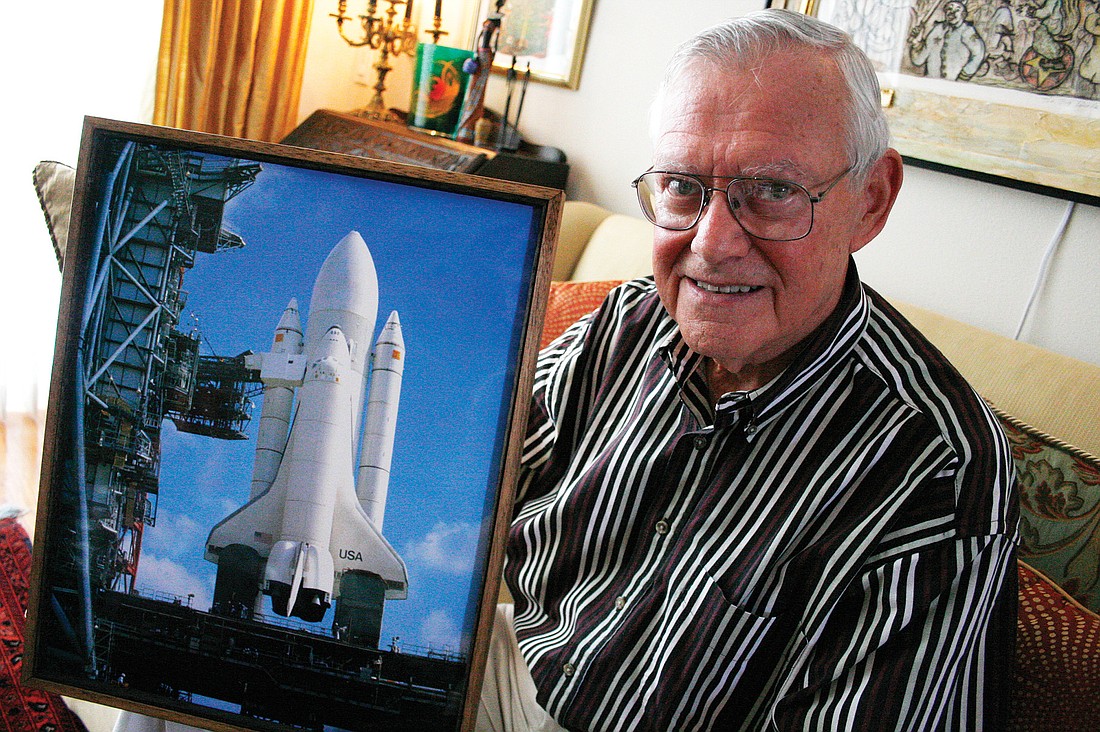- April 24, 2024
-
-
Loading

Loading

Stan Abshier shrugs as he holds a large photo of NASA’s first space shuttle. With a ballpoint pen, he points to the rocket boosters, the two, long segmented pieces flanking the shuttle on either side.
A retired chemical engineer, Abshier, during his time with United Technologies and Lockheed Martin, helped develop several technologies that helped propel man into space.
“People want to say, ‘Oh, it’s rocket science,’” he says. “But really, it was just normal guys with normal training getting together and working on a particular job.”
Yes, but only if that job is to take men out of this world.
The first solid booster
Abshier was working in Massachusetts when he learned about United Technologies, a small California-based company. During the Sputnik era of the late 1950s, the United States was failing in its attempt to launch satellites into space via liquid engines. United Technologies was seeking help to develop solid rocket boosters.
“I’ve always been interested in technologies,” Abshier says.
With United, Abshier helped design the solid boosters featured on the U.S. Air Force’s Titan IIIC space booster in 1965. The solid boosters were segmented and filled with a solid propellant fuel exhibiting characteristics similar to a pencil eraser. As the vehicle took flight, the boosters burned through the propellant and then ejected each piece. Using a solid fuel allowed control over the speed and intensity at which the fuel burned. Furthermore, by ejecting segments, the vehicle became lighter throughout liftoff.
The shuttle program
Four companies, including United, bid on a contract to develop the space shuttle. And although NASA did not choose United, the company did develop the small staging motors that would eject each of the booster segments during liftoff.
After 15 years with United, Abshier left to start his own business. He later returned to the rocket industry — this time with Lockheed Martin, which had won a bid to develop a more advanced shuttle.
As head of process engineering, Abshier was responsible not only for the development of the technology but also building the facilities and equipment necessary to manufacture the technology. In the late 1980s, NASA took over the partially completed Yellow Creek Nuclear Power Plant in Iuka, Miss., and Abshier worked to reconstruct the site to build solid rocket boosters.
“There was the base of one reactor there,” Abshier says. “We planted trees over the top of it.”
Lockheed was nearing completion at the site when Congress canceled the contract, instead opting to change the original design. NASA stripped the paint from the vehicle and adopted a lighter material for the fuel tanks.
Abshier continued working with Lockheed to develop technologies for the Trident and Poseidon missiles. He retired in 1997.
“We’ve done so much good work in the area of missiles,” he says. “There isn’t any place in the world we cannot hit.”
Although Lockheed’s design never was completed, many of the technologies Abshier helped develop were used in the shuttle. In addition to the boosters and staging motors, Abshier and his team also developed the solid fuel.
The final flight
Last week, Abshier watched Atlantis’ final liftoff on TV from his home in the Country Club of Lakewood Ranch.
“I’m sad about it,” he says of the ending of NASA’s shuttle program. “There was so much time and so much work that went into it. We advanced the whole world, as far as aerospace vehicles go.”
However, in retirement, Abshier has taken up a new cause — energy. Today, he teaches a course titled “Making the U.S. Energy Efficient” at State College of Florida’s Lifelong Learning Academy. He also believes the minds at NASA could be put to good use developing an energy policy for the country.
“We know NASA is full of great minds,” he says. “If we sic them on a project, they can really go.”
And, despite the shuttle program’s ending, Abshier remains proud of the work he completed throughout his career.
“We helped do things that hadn’t been done before,” he says. “I’m pleased we could contribute to the concept — the multiple parts of the rocket launch system.
“I’m proud,” Abshier says, then paused. “I’m really, very proud.”
Contact Michael Eng at [email protected].
NASA launches final shuttle
Hundreds of thousands of spectators flocked to Kennedy Space Center to witness STS-135, the final flight of NASA’s space shuttle program last week.
Despite rain the day before, space shuttle Atlantis lifted off at 11:29 a.m., July 8, carrying four astronauts for a 12-day mission to the International Space Station.
Source: NASA